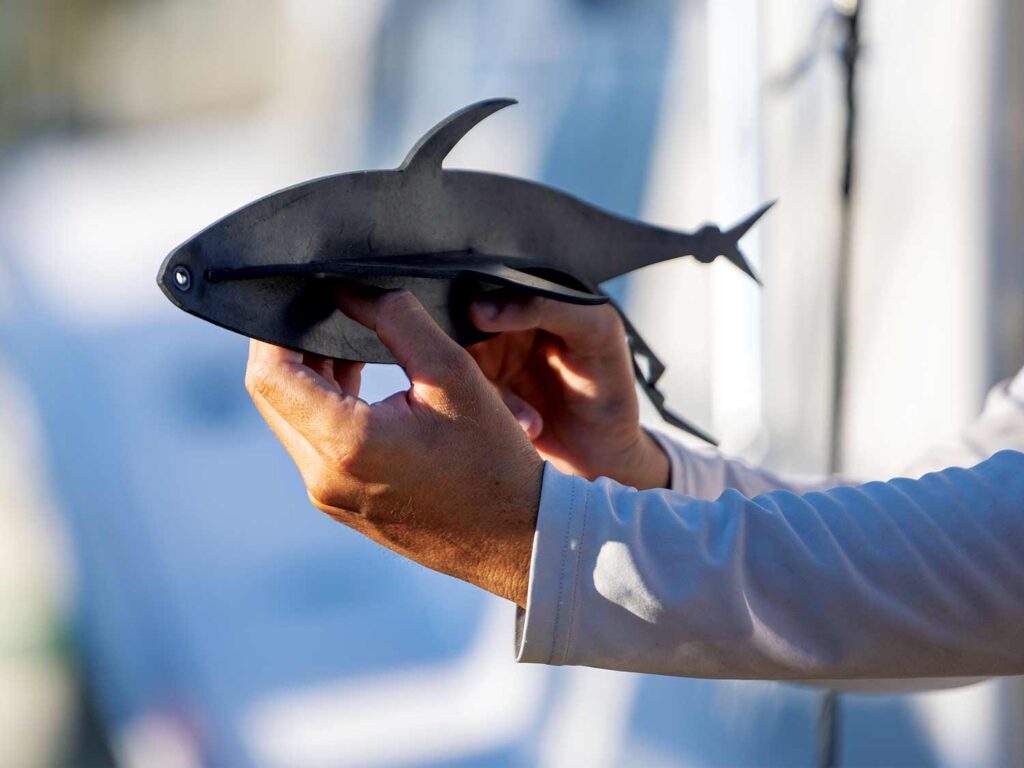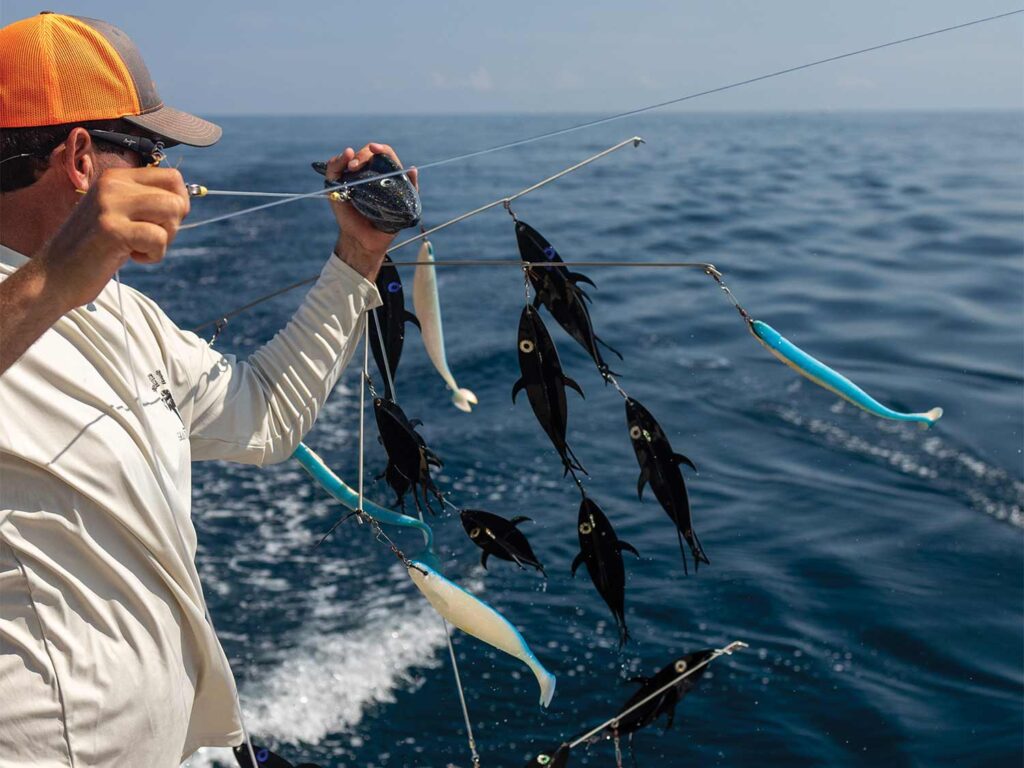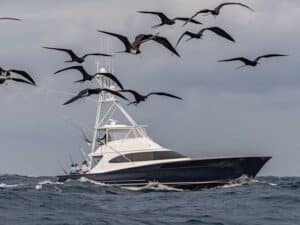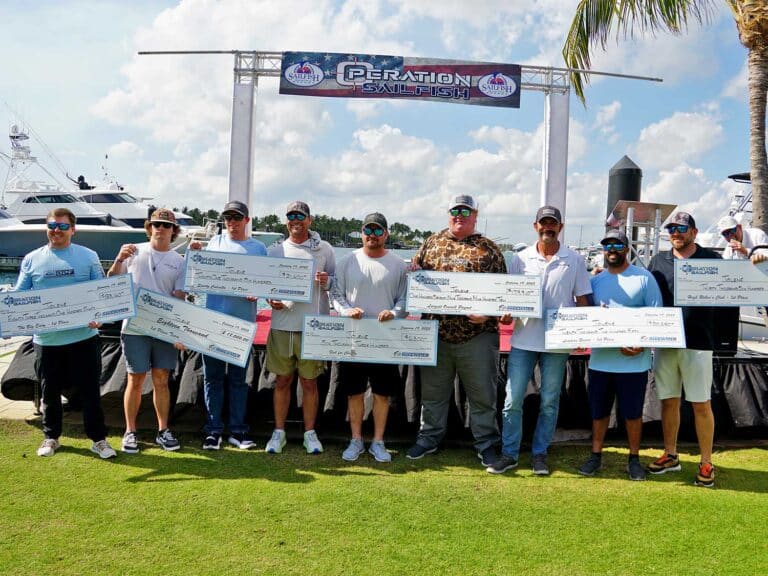
Special delivery: Sign up for the free Marlin email newsletter. Subscribe to Marlin magazine and get a year of highly collectible, keepsake editions – plus access to the digital edition and archives.
Do you remember those dinosaur toys made of wood pieces that would lock together to form the skeletons of Jurassic Park’s most formidable characters? Well, those kits weren’t the flashiest of toys, but it seems that folks from various generations recall playing with them at some point in their childhood. One man’s experiences with those rudimentary puzzle pieces would inspire a design that is now popping up in dredges and teaser chains around the world.
When you walk the docks of any active marina, especially during a tournament, it’s common to catch a glimpse of each crew’s choice of tackle. You’ll likely see a multitude of squid chains in an array of colors similar to what you might find in a box of crayons. You’ll also see schools of flat, black rubber tuna—commonly referred to as mud flaps—cut to various sizes. These two-dimensional mud flaps intend to mimic the silhouette of a live tuna, which have been around for quite a while but are now an important artificial teaser bait on almost every boat that targets billfish using dead bait or lures.
Flickers of Innovation
Capt. Grant Bentley runs Home Run, a 60-foot Spencer based out of Charleston, South Carolina, and has decades of experience raising blue marlin at home as well as destinations such as Mexico and Virginia Beach. Bentley has been using mud flaps in his spread since they were first made available many years ago. There are many perks to using mud flaps, and unlike dead baits such as ballyhoo or mullet, they can be used multiple times over. Tuna in general also make for pretty enticing prey. “Blue marlin want big meals,” Bentley explains. “If they’re going to exert the energy, it’s got to be worth the calories, and having low-drag flaps on your dredge looks like a banquet for any hungry or inquisitive blue marlin.”
When Bentley sat down for an evening of arts and crafts with his two young boys, he didn’t expect to bring work to the table. But innovation can spark anywhere, and Bentley restored the creativity of his youth with construction paper and a pair of scissors. “My boys were working on a project and were cutting out fish shapes from construction paper,” Bentley recalls. “As I sat down to help, I was thinking about those old dinosaur toys made of balsa wood. I took two fish shapes, made some slits in one, then pieced the two cutouts together. I bent one cutout into the other, slid it through, and popped it back out to form a three-dimensional fish. Then I thought, Shoot, I can do that with mud flaps!

Modification Creates Value
After developing the first batch of his 3D tuna, Bentley tried to keep it quiet. When walking by the boat with my camera several years ago, I was asked to not take a picture of the dredge as I was crouching down to do just that. Through friendly laughs and a flush of mild embarrassment, I quickly focused on something else. Bentley had a new tool that worked well for him, and he wasn’t quite ready to share it with others. “Since using the 3D tuna, I estimate that we’ve seen a 30 to 40 percent increase in the number of blue marlin sightings and bites,” Bentley says.
And as we know, sport-fishing secrets don’t stay secret for long. Soon, word spread of Bentley’s unusual mud flaps. He started selling them from his home but soon found that the demand was growing beyond what he could maintain himself. As their popularity soared, so did the need to partner up. Bentley still puts the pieces together, but Fish Razr now packages and sells them in stores and online.
All mud flaps seem pretty unimpressive when laying in the cockpit, but there are many considerations that go into such designs—the kinds of decisions which ensure that the artificial fish will swim correctly and efficiently through the water. Given how we’ve all seen them raise fish, it’s clear that they work. The source of their effectiveness is pretty simple, and it all points back to the billfish brain.
Read Next: Here are some pro tips on how to more effectively fish your dredges.
Brain Basics
The International Game Fish Association’s conservation director, Dr. Bruce Pohlot, has spent years studying billfish behavior. As a biologist and recreational fisherman, he understands the nuances of selecting the right tackle. “The billfish brain is designed for vision,” he says. “Think of sharks. They have enhanced capacity for electro-sensory ability and smell, so their brains are optimized for that. Conversely, the billfish brain is dominated by the structures used for vision.” So, a convincing tuna silhouette at or near the surface should bring on a bite, especially when considering how billfish vision works.
“A billfish’s vision is directed ‘fore-upper-fore,’ which means that their eyes see best ahead and slightly up,” Pohlot explains. “This helps them to see prey at the surface from just below. Billfish tend to hunt at the interface between light and dark, so imagine a billfish swimming at about 50 to 100 meters looking toward the surface to feed on schools of prey.”
Because dredges are equipped with multiple mud flaps at a time, they mimic another eye-catching prey behavior: “Abundance of schooling fish is probably the most likely behavior to attract a billfish,” Pohlot says. “Many of their favorite prey items form schools, and once that school becomes balled up at the surface due to predators, I think it probably triggers an instinctual reaction. Some have hypothesized that the surface activity seen by a large school of prey being eaten could be similar in sound or sight to a boat trolling at the surface, basically implying that fish will come up to check out what is going on as a boat trolls by. The fish then locates the spread and eats one of the baits.” That’s in a perfect world, of course.
It’s clear that all tuna mud flaps, whether two-dimensional or three-dimensional, play into the hand that billfish anglers have been dealt, and that we’re up against an opponent that has been evolutionarily programmed with exceptional vision. That means that the fake stuff better look real. On the deck, it’s just another rubber fish, but when pulled behind a boat and seen from a blue marlin’s vantage point, these 3D Tuna FlapZ baits are a veritable dinner-bell ringer.
Look for ways to up your artificial-dredge game at fishrazr.com.







